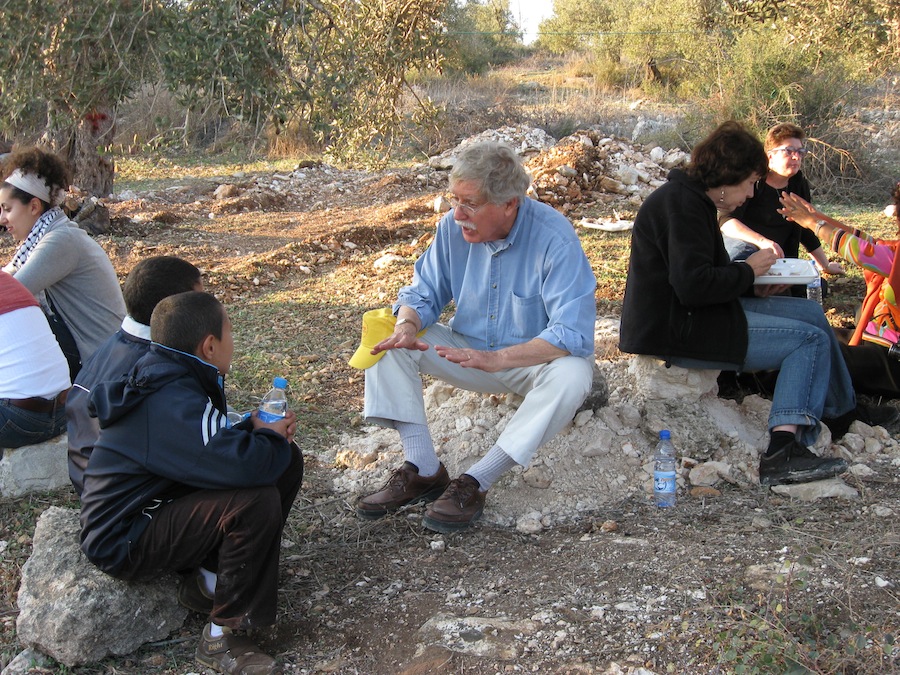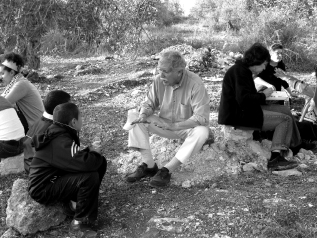Letters from Palestine (3 page)

I thought first of Dorothy herself, but
though she was interested, she begged off for multiple reasons,
including the fact that she would not be able to provide the
necessary translations from the Arabic for those of my respondents
who would have to write in that language. Instead, she suggested
that I try to sound out her friend, Ghassan Abdullah, about the
possibility.
In short order, I wrote to Ghassan to
introduce myself and then to boldly suggest that we collaborate on
this book. To my surprise and delight, he was agreeable to my
proposal. So it was that I now found myself working with a coauthor
I had never met and scarcely knew anything about! It was only the
first of many improbable experiences in my new life as a
Palestinian activist.
I didn’t quite realize it then, but I was
already on the road to Ramallah.
However, in the months to follow, I first
had to prepare myself for the journey I was determined to make by
throwing myself deeply into Palestinian studies. I began by reading
many books on the subject by American, Palestinian, and Israeli
writers so as to learn about different perspectives. In addition,
Anna and I watched perhaps a dozen or so documentaries and then
began to attend many local meetings of groups concerned with
Palestinian affairs and listen to their informative guest speakers.
We also had a chance to meet local Palestinians and Palestinian
activists, and in the course of soliciting potential participants
for the book, I began to correspond with various Palestinians in
the West Bank, Gaza, and, of course, here in America. Over time, I
also made contact with quite a few professionals involved in this
work—journalists, authors, researchers, academics, graduate
students, et cetera. In a number of cases, I became involved in the
lives and concerns of some of these people, especially in Gaza, and
deep relationships formed between us. All of these individuals
eventually consented to contribute to our book as well.
During this time, Anna was pursuing and
deepening her involvement with Palestinian causes in her own way,
but both of us were aware that to establish our work on a sound and
informed basis, we would soon have to go to Israel and the West
Bank ourselves. Anna is a seasoned traveler but had never been to
the Middle East, nor had I. Indeed, having done my share of foreign
travel during my career but now suffering from the frailties of
aging, I was not keen to do more. But in this case, existential
imperatives trumped personal preferences, and my reluctance to go
abroad again was quickly overcome. Indeed, we both found ourselves
eager to go.
A friend of mine had recommended a group
called Interfaith Peace-Builders, which conducted periodic tours of
the sort we wanted to take, so we quickly signed up with them. Our
delegation of about twenty, mostly Americans and a few Brits, left
for Israel shortly after the American elections when Barack Obama
gained the presidency early in November 2008.
The tour itself lasted about two weeks
during which time we had a chance to see for ourselves many of the
things and places we had only read about or seen in documentaries.
We were based in East Jerusalem but spent a lot of time traveling
through the West Bank—to Jenin, Hebron, Bil’in, Ramallah, Birzeit,
Bethlehem, Beit Sahour, and many other towns and villages—during
which time we met or had the opportunity to listen to many
individuals who were engaged in various forms of nonviolent peace
work or other forms of activism. We also spent a fair amount of
time in Israel—in West Jerusalem, Tel Aviv, and Sderot, which had
already become famous as a town plagued by occasional attacks by
Qassam rockets fired from Gaza (one had landed there the night
before our visit) and was to become even more newsworthy shortly
after we left during the days of Israel’s assault on Gaza,
beginning in late December 2008, when the rocket fire intensified
greatly in that area.
Our visit provided me with opportunities to
meet many Palestinians face-to-face (Anna and I were even able to
stay overnight in the homes of some Palestinian families), some of
whom kindly agreed to contribute to our book. And when our
delegation was finally concluded, both Anna and I remained
afterward to pursue our own private professional interests.
We had previously been to Ramallah with the
delegation, but now we were able to return so that I could finally
meet and consult with my coeditor, Ghassan, and meet his wife,
Anita, and his mother, Nadia. I was finally literally on the road
to Ramallah (complete with the notorious Qalandia checkpoint that
you’ll be reading about in this book). After our Palestinian
driver, Saïd (who had actually been our expert and authoritative
guide on our tour), had managed to get us through, we were met by
Ghassan and taken to his home where we spent two delightful (and
productive) days. After that, Anna and I traveled to Tel Aviv where
we were able to have a reunion with Dorothy Naor. Dorothy took us
back into the West Bank where we were able to meet and spend time
visiting with several families that Dorothy was close to, and I was
able to talk with two more people whom I had very much wanted to
include in our book.
Naturally, I could write at length about my
impressions of Palestine and the Palestinian people we met during
the nearly three weeks we were there, but this is not the place for
travelers’ tales of that sort. My job in this book, after all, is
to introduce you to Palestinians, not to provide my own verbal
snapshots of them or their country. Let it suffice, then, for me
merely to say that one of my biggest fears before setting out on
this journey was that I might be somewhat disappointed or even
disillusioned with the Palestinian people I would be meeting. I can
assure you that, if anything, my expectations were not only met,
but exceeded. The Palestinians we encountered were just like those
described in the many books I had read—kind, warmhearted,
hospitable to a fault, and very welcoming wherever we went. My
experience in Palestine only made me more eager to begin work on
our book in earnest after my return home so that I could, if only
through vicarious means, have the pleasure of introducing them to
you.
K enneth Ring tal
enneth Ring tal
king to a couple of Palestinian
brothers near Jenin. Anna is immediately to
his right

And so, finally, to this book, which is our
vehicle for doing exactly that.
The chief aim of our book remains
essentially the same as in my original note to Dorothy Naor when
the idea for it first occurred to me, namely, to present personal
accounts by Palestinian people with diverse backgrounds concerning
what it is like to live in the Occupied Territories (or elsewhere
in the Palestinian diaspora) these days. One of the main goals of
our book is to make it clear that the kind of stereotypes that many
Americans may have about Palestinians, often amounting to little
more than media-derived caricatures, are without foundation and
need to be combated by providing compelling counter-images based on
the lives and experiences of actual Palestinian people.
In short, the intent of the book is to put
“a human face” on the abstraction, “the Palestinian people,” so
that an American audience can see them as individuals who have to
confront, with courage, humor, and pluck, the often impossible and
impossibly cruel conditions imposed on them by the Israeli
government, the settlers, border police, Israeli Occupation Forces
(IOF), and other agencies of Israeli social control. Our purpose
here is not merely to evoke sympathy for these hardships but mainly
to show that people living in Palestine are like any other with the
same kind of aspirations, dreams, and desires that many Americans
have, that they are in fact our brothers and sisters and not at all
those whom we need to fear or regard as “other.” In addition, given
the American audience for whom this book is intended, we will also
feature stories written by American-born Palestinians who describe
the particular challenges and sometimes surreal interactions they
have to confront in the course of growing up Palestinian in a
country that has frequently been hostile to and indeed often
ignorant of Arab culture.
Our means of conveying these glimpses into
the everyday lives of Palestinians has been to solicit personal
stories, almost as if each contributor is writing a letter to an
American friend, that will give the reader a vivid sense both of
the writer’s own personality and his or her daily life in Palestine
or elsewhere in the diaspora. Many of these accounts, often
highlighting one or more particularly significant and illuminating
event in the writer’s life, were written specifically for this
book. Others have been drawn from actual letters, short articles
and essays, interviews, blogs, et cetera. Each contribution is
accompanied by a photograph of the writer and a summary statement
that provides some biographical information about him or her. In
some cases, I will also include a brief introduction of my own,
which will give a personal context for the story to follow based on
my own prior contact with the writer.
Altogether, about thirty contributors are
represented in this book, representing a wide variety of
backgrounds and experiences. Most of them come either from the West
Bank or Gaza, but there are also Palestinians who live elsewhere in
the Middle East or in America. Quite a few are young people, which
makes sense since Palestine is such a youthful culture, but there
are people of mature years, too, of course, whose stories also are
told in this book.
Among our contributors, you will meet a
number of gifted students (including three Fulbright Scholars),
several poets, a couple of documentary filmmakers, various
journalists and editors, some activists, a few academics, and then
“just ordinary” working people—all of whom together provide a rich
and diverse tapestry of contemporary Palestinian-lived experience.
The content of their stories include not only accounts of the
everyday trials, hassles, and humiliations that Palestinians suffer
but also inspiring tales of triumphs over these adversities and the
use of humor to cope with the absurdities of life under occupation.
All in all, they serve to demonstrate the resourcefulness,
resilience, and creativity of Palestinian people. There are also
stories of life under the destructive sieges of 2002, and the book
ends with some searing firsthand dispatches that describe what
people experienced during the devastating bombardment of Gaza for
twenty-two days, beginning in late December 2008.
We hope you will enjoy meeting the people
whose stories are collected in this book and listening to their
voices. Through telling their stories, as if they are writing
letters from (or about) Palestine to you, their distinctive
personalities will also shine through their words, and perhaps by
the end, you may feel that some of them are, or easily could be,
your friends. In the course of working on this book, they have
certainly become mine.
Kenneth Ring
April 2009
Growing Up Palestinian
To begin this section, three young American
women of Palestinian descent describe what it was like for them to
grow up Palestinian in a culture where they were made to feel like
aliens—or worse. This section then concludes with two further
accounts, one in the form of poetry, by Palestinians who grew up
either in Israel or elsewhere in the Middle East and who
experienced the effects of discrimination and brutality firsthand
as a part of their everyday life.
Shireen’s Stories

